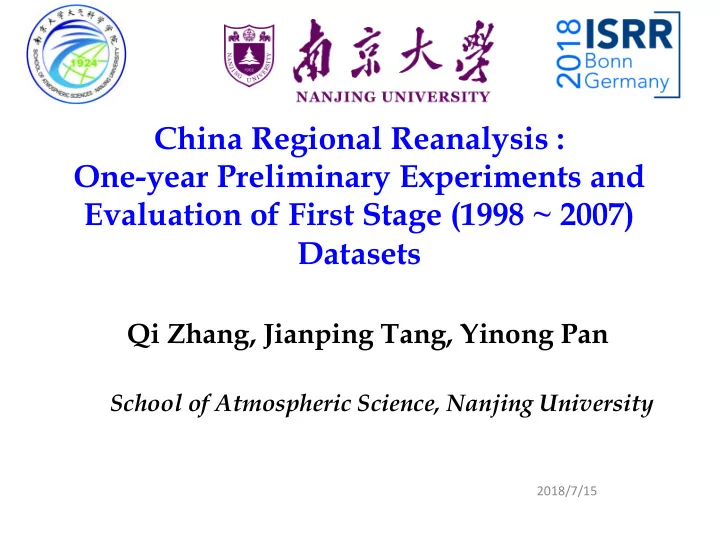

China Regional Reanalysis : One-year Preliminary Experiments and Evaluation of First Stage (1998 ~ 2007) Datasets Qi Zhang, Jianping Tang, Yinong Pan School of Atmospheric Science, Nanjing University 2018/7/15
Outline Ø Motivation Ø CNRR Experiments Design Ø Evaluation of 1-Year Period Experiments Ø Preliminary Results of 10-Year CNRR Ø Conclusions
Motivation East Asia especially China is an area suffering many kinds of natural hazard caused by extreme atmospheric events. Severe Convective Systems Tropical Cyclone Snow Storm Heat Wave High temporal and spatial resolution of atmospheric best estimation is needed!
What is Regional Reanalysis 1. Based on data assimilation method and regional model 2. Driven by the global or regional reanalysis 3. Provide higher resolution gridded reanalysis data Name Time Region Resolution NARR (2006) 1979-now North American 36km 3hourly ASR ( 2016) 2000-2010 Arctic 15km 3hourly EURO4M (2013) 1989-2010 Europe 0.2degree 6hourly 2014 – 2017 South Asia IMDAA (2014) 12km 6hourly EARR (2017) 2013-2014 East Asia 12km 6hourly North American regional Arctic EURO4M regional Regional Reanalysis System Reanalysis reanalysis system (NARR) (ASR)
Prototype CNRR Workflow Design Model Configuration Model prototype WRF Data Used by CNRR Governing equations Nonhydrostatic CFSR ingest datasets Conventional Grids and resolution 481x361, 18km with China local Observation Data Vertical Layers (top) 45 sigma layers (10hPa) sounding data added Satellite Radiance Cumulus convection Kain-Friticsh CFSR ingest datasets Data Explicit moisture WSM5 Initial and ERA-Interim 6-hourly PBL MYJ Boundary globab reanalysis in Radiation RRTMG pessure level Condition Land Surface NOAH LSM Sea Surface NCEP Daily OISST DA Scheme 3Dvar Temperature
Evaluation of 1-Year Period Experiment based on 2013 p Test the performance of CNRR with GSI method p Compare the GSI and Spectral Nudging (SN) in CNRR
One-Year (2013) CNRR Experiments Technical route We have tested in Preliminary Experiments Traditional downscaling CNRR-CTL ...... 2012-12-01 00 2013 12-31 18 Every 6 hour UTC UTC ...... 2012-12-01 00 2013 12-31 18 ) t r Every 6 hour o h s UTC UTC n i N S ( g n i CNRR-SN g d u N a l r t c e p S Spectal Nudging ...... 2012-12-01 00 2013 12-31 18 Data Assimilation (GSI in short) Every 6 hour UTC UTC CNRR-GSI GSI ...... 2012-12-01 00 2013 12-31 18 Hybrid method (GSISN) Every 6 hour UTC UTC CNRR-GSN Spectal GSI Nudging
Statistical Parameters of 2m AGL Temperature ( Bias, RMSE, CORR )
Statistical Parameters of Daily Precipitation ( Bias, RMSE, CORR ) Ø CNRR can reproduce the spatial-temporal distributions of near surface meteorological variables
(a) (b) (c) Heat Waves in 2013 Spatial Correlations of GHT at 500 hPa Ø The GSI methods can accurately simulate the heat waves during the summer of 2013 by improving the reproduction of large-scale circulations
RMSE Profile of upper level variables Ø The analysis of the CNRR experiments with the GSI method (CNRR-GSI, CNRR-GSN) is closer to the sounding observation than the ERA-Interim reanalysis for the specific humidity at low troposphere and winds at middle and high troposphere
Preliminary Results of 10-Year CNRR ü Evaluation of the 10-year CNRR ü Compare CNRR GSI methods assimilated with different dataset
10-Year CNRR Experiments: Workflow Every 6 hour Cycle 1997010100 1997010106 2007123118 2008010100 CNRR_GSIERA Hincast 6 hour Hindcast Initial condition Data Assimilation Observation Initial Condition generated from Every 6 hour Cycle 1997010100 1997010106 2007123118 2008010100 CNRR_GSIERA Hincast ERA-Interim 6 hour Hindcast Initial condition Data Assimilation ERA-Interim CNRR_SNUVTQ Nudging Spectral Nudging Informatio Every Time Step 1997010100 1997010106 2007123118 2008010100 Hincast
Overview of Monthly Precipitation CNRR-GSISAT CNRR-GSIERA CNRR-SNUVTQ CMORPH CN05.1 Data assimilation (DA) with observation’s performance is the best especially in ocean regions, DA with reanalysis is inferior but better than spectral nudging.
Frequency Distribution of Daily Precipitation Under-estimation of precipitation occurrence is relieved in data assimilation experiments; DA with reanalysis performs better in extreme precipitation events.
Statistical Parameters of Daily Precipitation ( Bias, RMSE, CORR ) DA with Observation is best and DA with reanalysis has significant improvement in simulating summer precipitation
Temporal Variations of Daily Precipitation and Temperature Precipitation Daily mean Temperature Near surface temperature’s performance difference is identical to Precipitation Data assimilation experiments exhibit performance enhancement in South and Southwest China
Upper Level Variables: 10-year averaged spatial Bias RMSE and CORR
Specific Geographical Temperature V wind U wind humidity height Upper Level Variables’ 5-day mean RMSE
Conclusions Ø Assimilating satellite radiance and conventional radiosonde data into a WRF modeling system every 6 h during the study period, thus providing a physically and dynamically consistent regional climate estimate in China. Ø Assimilating reanalysis dataset in replacement of authentic observation is proved to be a feasible approach because this method performs better than spectral nudging. Ø Considering computational consumption, conducting regional downscaling by using reanalysis-data-assimilated method is a win-win decision for the fact that it takes relatively small computational and storage resources but achieves promising performance.
Recommend
More recommend